
21 Nov Hilo Home Inspector: Top Tips for Hawaii Home Cooling
Are you grappling with high cooling costs in Hilo’s sultry climate? You’re not alone. In my extensive experience as a home inspection expert, I’ve helped countless homeowners on the Big Island pinpoint where hot air seeps in and cool breezes slip out. This article sheds light on practical, energy-efficient strategies to enhance home cooling. From boosting insulation to harnessing the island‘s breezes, I’ll guide you through low-impact fixes to high-tech systems—and even discuss how tying in renewable sources can cool your home more sustainably. By optimizing your roofing, plumbing, and termite protection, you can secure not just comfort but also peace of mind, potentially even lowering insurance costs. Let’s tackle these tropical challenges together to achieve a cooler, energy-smart home.
Key Takeaways
- Tropical climate in Hilo demands tailored cooling solutions for energy efficiency
- Regular home inspections are crucial for maintaining proper ventilation and insulation
- Embracing smart technologies and renewable energy reduces cooling costs and carbon footprint
- Strategic home design leveraging natural ventilation offers substantial energy savings
- Sustainable cooling methods increase property value and align with Hawaii‘s environmental goals
Understanding Hilo’s Tropical Climate and Its Impact on Home Cooling
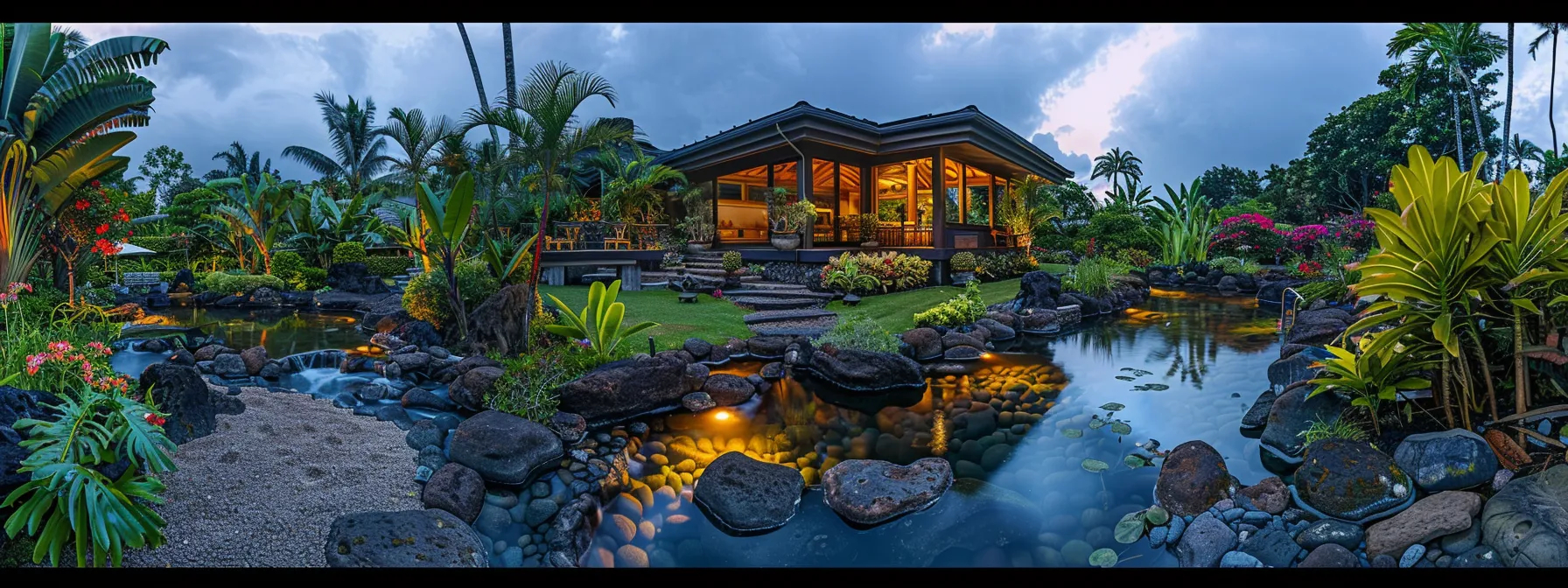
As a seasoned home inspector in Hilo, I’ve observed firsthand the unique challenges presented by Hawaii‘s tropical climate, especially regarding heat and humidity in our homes. These conditions significantly influence energy consumption on the Big Island, prompting many to seek more efficient home cooling solutions. My insights aim to shed light on the effects of our lush environment on home cooling needs and the essential considerations for real estate agents and homeowners during water-related inspections. I’ll guide you through adapting your living spaces to combat these tropical influences smartly and sustainably.
The Challenges of Heat and Humidity in Hilo Homes
Through my widespread experience as a home inspector across the Big Island, I’ve come to recognize the pressing challenge heat and humidity pose to homes in Hilo. The persistent warmth can lead to overreliance on air conditioning, escalating both energy use and utility costs. What’s more, these climatic factors create an environment where mold can thrive, potentially compromising not only the property‘s integrity but also the health of its inhabitants.
As I navigate various real estate properties in my daily inspections, I’ve discerned a clear link between inadequate cooling solutions and accelerated wear on homes. Excessive heat doesn’t just cause discomfort; it can damage structures, warp materials, and strain mechanical systems, all of which play a critical role in property valuation and longevity. Homebuyers and sellers must be informed about the specific cooling needs of each property for their investment to stand the test of time.
Insights From a Home Inspector in Hilo on Climate Effects
In my professional capacity as the owner of Ash the Home Inspector LLC, I can attest that the bustling investment in Hilo’s real estate and housing sector demands keen awareness of our climate’s impact. Notably, attic ventilation significantly affects the efficiency of water heating systems, with poor design leading to higher humidity and thermal inefficiency. As a member of the American Society of Home Inspectors, I emphasize the importance of tailoring home inspections to include comprehensive reviews of climate control systems, ensuring they are optimized for our unique environment.
Radon detection is another aspect that I urge homeowners and property managers to consider, given that radon levels can be influenced by the tropical climate and can vary from region to region. It is critical that energy-smart cooling solutions not only mitigate the harsh effects of our tropical setting on home comfort but also promote a healthier living space. Practical steps such as regular inspections and installations of radon mitigation systems are part of a holistic approach to maintaining property value and safeguarding dwellers’ well-being:
- Conduct thorough attic inspections for proper ventilation and insulation adequacy.
- Implement water heating systems designed for high humidity conditions.
- Incorporate radon assessments and mitigation strategies in routine home maintenance.
How Tropical Weather Influences Energy Usage on the Big Island
In my role as the owner of Ash the Home Inspector LLC serving homeowners in Hilo, I’ve noted that the relentless island heat significantly ramps up residential energy demands. Across Maui and the Big Island, air conditioning usage isn’t just a comfort; it’s a necessity, influencing construction choices with emphasis on energy-efficient design to mitigate costs. Lessons from my customer interactions in Hilo and observations in Honolulu reveal that well-planned natural ventilation can reduce reliance on air cooling systems, highlighting the importance of incorporating smart construction practices in tropical climates.
Another aspect essential to structural longevity in these warm regions is the prevention of heat buildup. I’ve witnessed many homes without proper chimney ventilation, which worsens indoor air quality and leads to increased use of electric fans and HVAC systems. As a solution-focused home inspection expert, I consistently guide my clients towards construction modifications and maintenance routines that keep their living spaces cooler and energy bills lower, directly impacting their comfort and financial well-being.
In Hilo, the sun does more than glisten on ocean waves; it heats our homes. Let’s see how a diligent inspection reveals where cool air escapes, and costs climb.
Identifying Cooling Inefficiencies Through Big Island Home Inspections
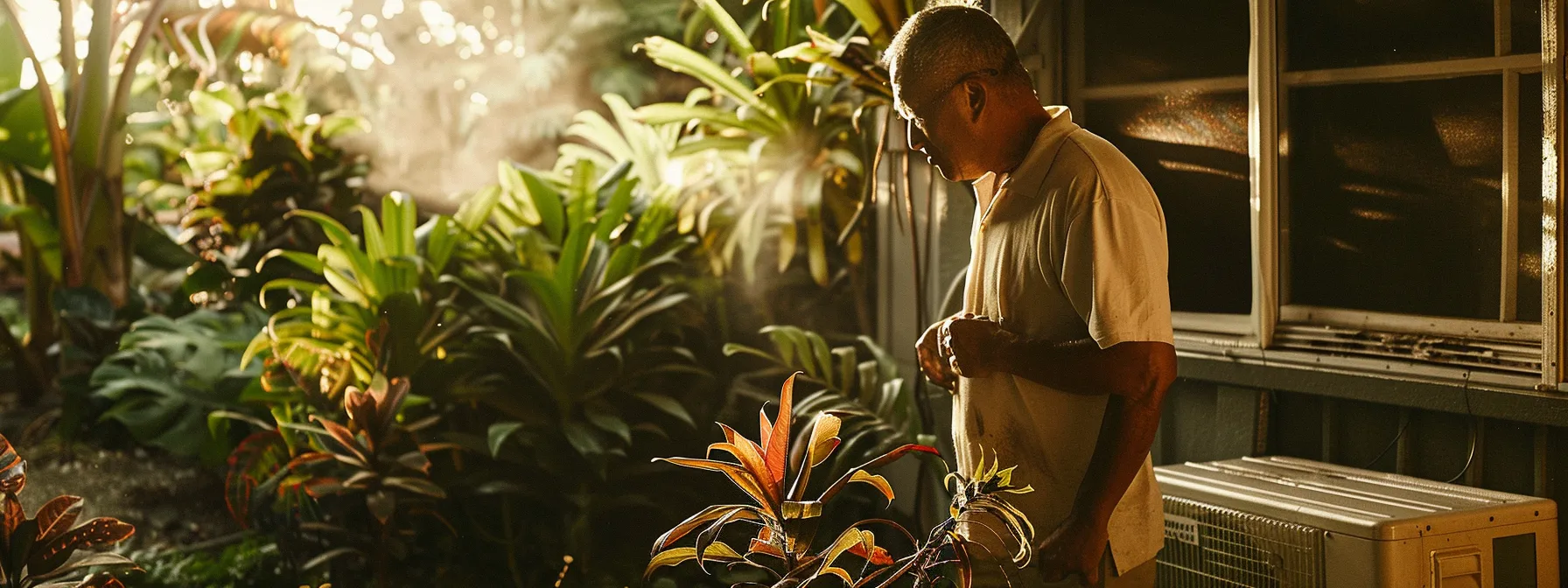
In my profession as a home inspector in Hilo, unearthing cooling inefficiencies is a fundamental aspect of my service. Homes in Hawaii often contend with common energy loss areas that, if unaddressed, can lead to excessive power usage and high utility bills. I assist home buyers in understanding the complexities of their cooling systems, urge reviews of their plumbing system, and suggest timely inspections. Engaging a home inspection expert is a strategic move, enhancing energy efficiency and cooling effectiveness. For convenience, clients can schedule or even schedule online an inspection to identify and remedy these inefficiencies, bringing along significant cost savings and improved indoor comfort.
Common Energy Loss Areas Found in Hawaiian Homes
In my experience as a home inspector, I’ve pinpointed indoor air quality as a casualty of energy loss, particularly in Hawaiian homes where poor ventilation hampers the efficacy of cooling systems. From insufficient insulation to leaks in windows and doors, these are regular culprits contributing to the decline in indoor air quality, leading to a cycle of overuse and inefficiency in air conditioners.
Another frequent observation within our community relates to inadequate drainage and the absence of fire stops. Both can significantly affect a home’s overall energy profile by letting in outside air which disrupts the controlled climate of the interiors. This insight is part of the domain-specific knowledge I convey to homeowners, empowering them to optimize their living spaces for energy conservation and enhanced cooling efficiency.
The Role of Home Inspection Hawaii Experts in Enhancing Efficiency
In my professional capacity, conducting an evaluation of home cooling systems is an integral part of the inspection services I provide here in Hilo, which extend across the wider Kauai region. Each kitchen, a common hotspot for inefficiencies, receives a meticulous review to ensure that the heart of the home remains comfortable without squandering energy. Through these examinations, I assist homeowners in uncovering hidden issues that could escalate their costs and compromise their living environment.
Additionally, it is my responsibility to enlighten clients on the myriad benefits of carrying liability insurance for their property. Such insights are especially valuable in the United States, where severe climatic conditions can lead to unexpected repair needs. By advocating for comprehensive home inspections, I aim to bolster efficiency improvements that safeguard homeowners against potential fiscal strains arising from cooling system faults or inefficiencies.
Benefits of Professional Home Inspections for Cooling Solutions
In my capacity as a home inspector, I’ve frequently seen how bathroom ventilation or lack thereof, can drastically alter a home’s cooling system. With professional inspections, homeowners gain the certification needed for peace of mind. It ensures that the right ventilation is in place to assist in the efficient flow of air and prevention of smoke buildup, which is not only a health hazard but also a common cooling inefficiency that often goes unnoticed.
Moreover, clients can approach home cooling with greater confidence when they understand their systems’ workings. Through my inspections, they’ve been able to make informed decisions about upgrades or maintenance that are most effective for their specific climate and home. It is my priority to help them realize substantial energy savings while ensuring that their living environment remains temperate and comfortable.
Inspection reveals the truth: our homes bleed cool air like sieves. Next, we’ll tackle the insulation fix, a straightforward step to keep the chill where it belongs.
Enhancing Insulation for Energy-Smart Cooling in Hilo
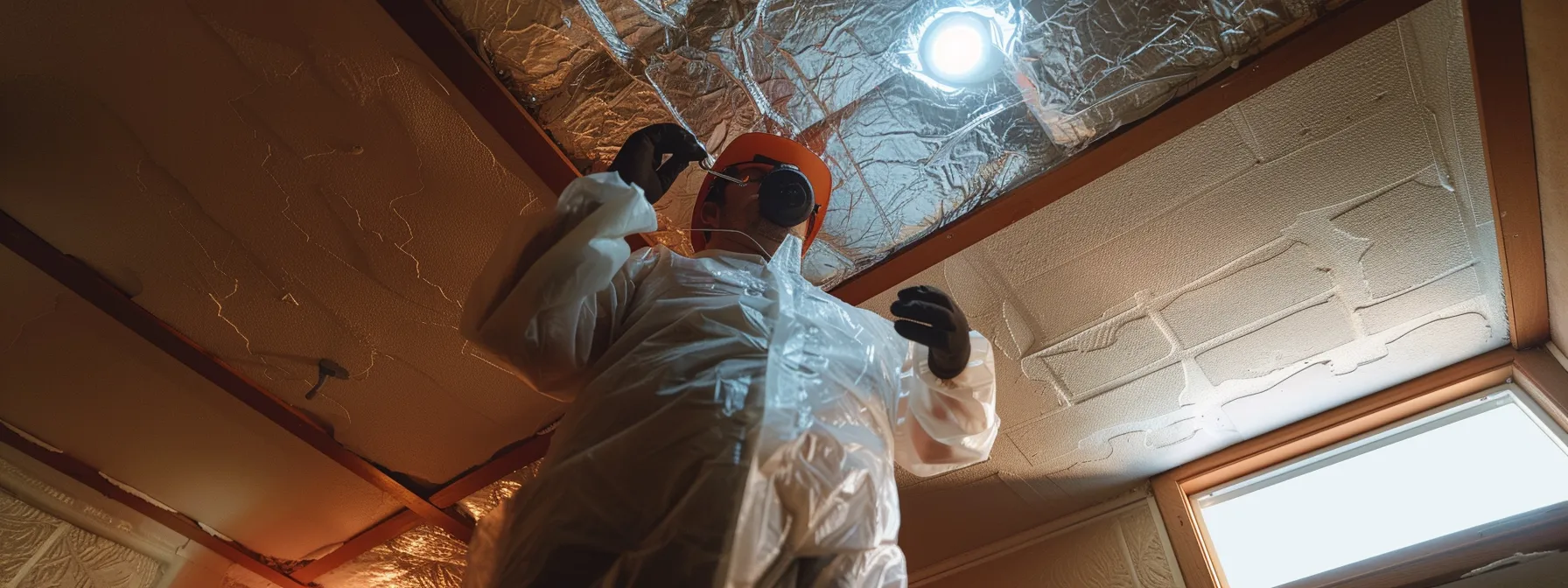
In my role as a trusted home inspection specialist on the Big Island, I’ve identified that selecting the right insulation materials is crucial for homes in Hilo’s tropical climate. Drawing on my expertise, I offer recommendations tailored to withstand the unique challenges of living near active volcanoes, ensuring basements stay dry and ceilings in condominiums are properly insulated. With proper home insulation, residents can effectively reduce their energy bills while keeping their homes cool and comfortable. I’m here to guide you through enhancing insulation for energy-smart cooling that stands up to Hilo’s warmth and humidity.
Choosing the Right Insulation Materials for Tropical Climates
In my extensive experience as a home inspector in Hawaii, I’ve learned the importance of choosing insulation materials that can withstand the moisture and heat characteristic of Hilo’s climate. During my professional home inspections, I often come across insulation that has deteriorated due to these conditions, resulting in higher energy costs for homeowners. It’s vital to use moisture-resistant materials that not only insulate but also prevent mold growth, which is a common concern in our tropical environment.
Another key aspect to consider when selecting insulation in Hilo is the potential presence of lead paint, especially in older homes. My role as your home inspector is to ensure that proper procedures are followed to safeguard your living spaces. Mitigating risks associated with outdated materials is a focal point of Hawaii home inspections, making it imperative to choose insulation that compliments both the price-point and the safety standards expected in professional home inspections.
Recommendations From Big Island Home Inspection Specialists
In my practice as a general home inspection expert serving Hilo, I’ve identified a critical action point for homeowners aiming to optimize their energy efficiency: selecting appropriate insulation for your home. On my website, you’ll find comprehensive guidance on the latest insulation materials and techniques that are best suited to our tropical climate, a resource I’ve tailored to ensure that your living space remains cool and serene without unnecessary energy expenditure.
When conducting inspections, I’ve repeatedly stressed to residents the significance of professional assessments of their insulation status. In fact, expert home inspectors like myself can detect and advise on energy-saving opportunities that might otherwise be overlooked. Through meticulous inspections, I provide actionable insights to bolster your home’s defense against the relentless Hawaiian heat, ensuring comfort and cost-effectiveness go hand-in-hand.
Reducing Energy Bills With Proper Home Insulation
In my rigorous home inspection services across the island, I’ve repeatedly highlighted that proper insulation is key to maintaining safety and reducing energy costs. Homes without adequate insulation can lead to the growth of indoor mold—a risk factor for both health and structural integrity. Through conscientious inspection and assessment, I aid homeowners in Hilo and Oahu in selecting insulation solutions that fortify their homes against these energy inefficiencies.
Focusing on the long-term well-being of the property, I underscore the significance of proper insulation in conserving energy and thereby reducing utility bills. My inspections often reveal opportunities where slight modifications in insulation can lead to substantial savings. I guide my clients through the process of upgrading their home’s defense against the tropical climate, emphasizing the dual benefits of cost efficiency and enhanced indoor comfort.
As we fortify our homes against the warmth, the trade winds whisper another secret. The next step is simple: we open our walls to the breeze, our roofs to the shade.
Maximizing Natural Ventilation and Shade in Your Home
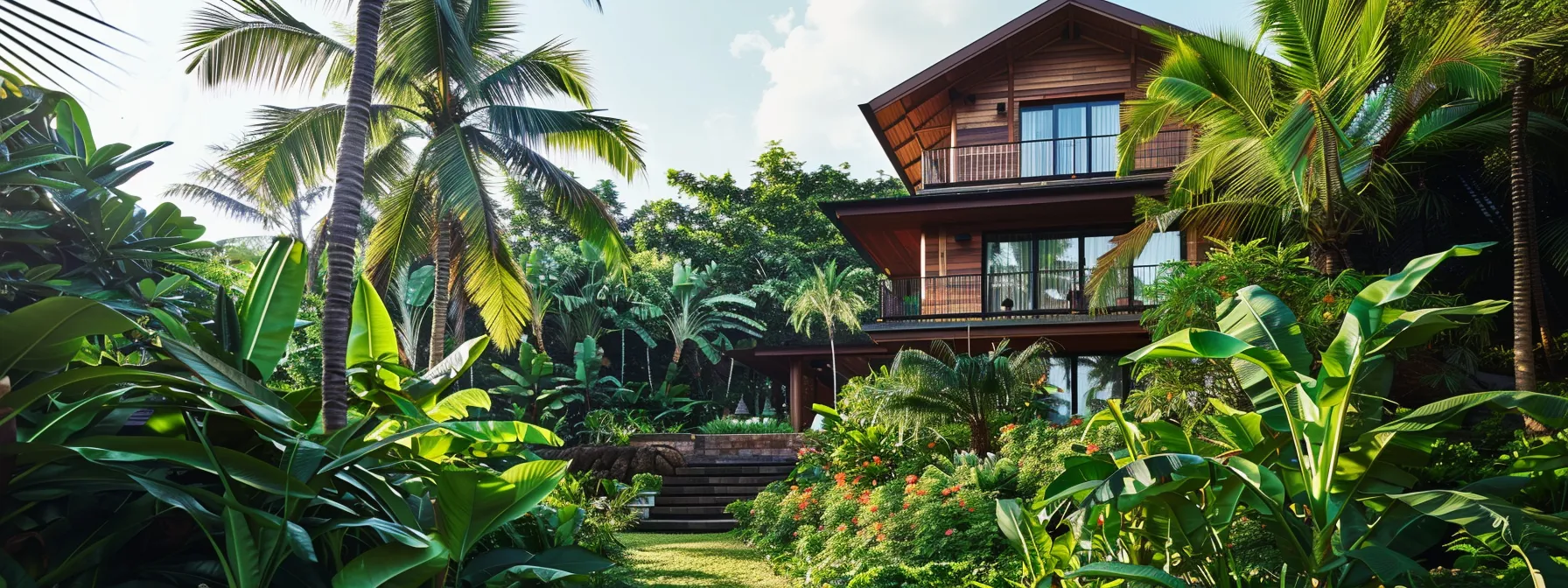
In my experience as a home inspector, learning to harness the trade winds is crucial for designing homes with efficient natural ventilation in Hilo’s tropics. By integrating strategic landscaping that reduces heat gain, structures remain cooler without overreliance on mechanical cooling systems. My tips echo the wisdom of seasoned estate agents and speak to the core of practical property inspections—whether it’s a residential home or a commercial property. The observations I’ve gathered and am about to share through my LLC can guide you in improving ventilation, cutting down energy use, and potentially reducing your next energy bill payment.
Designing Homes to Capture Cooling Trade Winds
In my years of inspecting homes here on Big Island, I’ve advised countless homeowners on leveraging the cooling benefits of trade winds. By strategically positioning windows and operable skylights, we can create a natural airflow that harnesses these winds, significantly reducing the need for artificial cooling. It’s a smart design choice that not only improves home comfort but is also grounded in energy-conscious living.
Another element I emphasize in home design is the orientation of the building itself. Aligning living spaces to face the breeze while using landscaping elements to funnel winds effectively can transform stifling rooms into havens of coolness. This expertise, gained through dedicated inspection practices, is crucial for homeowners who wish to enjoy an energy-efficient and naturally temperate home environment in Hilo’s warm climate.
Utilizing Landscaping to Minimize Heat Gain
As a home inspector, I’ve seen the transformative impact of thoughtful landscaping on home cooling. Incorporating shade trees and shrubs in particular orientations not only beautifies your property but actively reduces thermal penetration. These green barriers, especially when planted on the sunniest sides of a home, act as an organic insulation layer, curbing indoor temperatures naturally and diminishing reliance on man-made cooling systems.
Furthermore, in my field experience, I advise that leveraging the natural topography of your land can markedly cut down heat gain. Constructing awnings or pergolas with climbing plants for instance, creates shaded areas which serve as cool retreats and buffer zones, preventing direct sunlight from overheating your interiors. These simple, yet effective strategies are central to cultivating a more energy-efficient residence in Hilo’s warm climate.
Tips From Home Inspectors in Hilo on Improving Ventilation
In my practice as a home inspector, I prioritise ensuring proper ventilation is a cornerstone of maintaining a comfortable and energy-efficient home. My advice includes installing vented soffits and ridge vents to create an effective air exchange system; this maximizes natural ventilation and helps prevent heat accumulation in attics, a common issue in Hilo’s homes. Strategic placement of vents takes advantage of the island‘s breezes, offering a sustainable cooling solution and potentially reducing dependency on energy-consuming air conditioners.
To further enhance natural airflow, I recommend integrating operable windows or louvers into strategic areas of your home. These allow for the manual control of ventilation based on daily weather conditions, enabling residents to efficiently manage their indoor air quality and temperature:
| Room | Ventilation Enhancement |
|---|---|
| Kitchen | Operable windows or louvers for steam release |
| Living Area | Vented soffits to maximize cross-breezes |
| Bedrooms | Strategically-placed louvers for individual comfort |
My experience shows that such practical alterations can significantly lessen the heat load within a home, an approach that is particularly beneficial given the tropical warmth we face year-round in Hilo.
Harnessing the breeze and shading our homes brings us closer to nature’s rhythm. But to truly control the heat, let’s now turn to clever, energy-conserving technologies.
Implementing Energy-Efficient Cooling Systems and Technologies
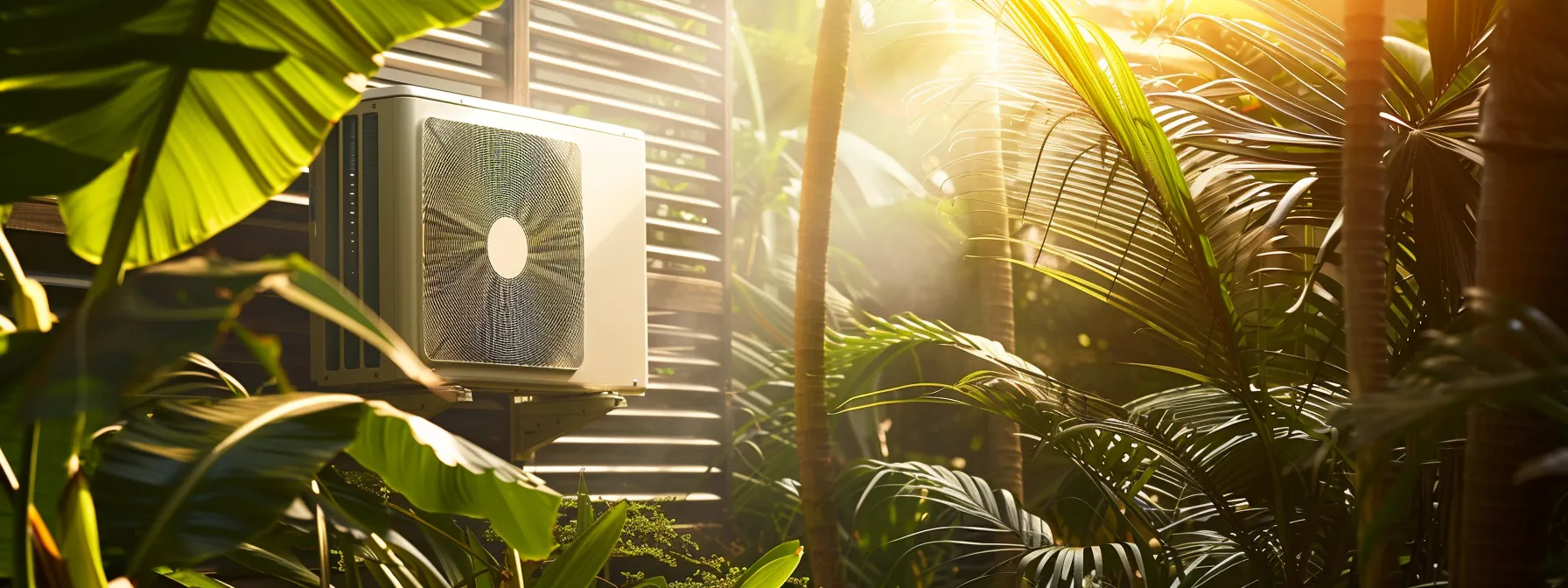
In my years as a home inspector in Hilo, I’ve observed a growing trend towards adopting energy-efficient cooling systems and technologies. Exploring alternative cooling methods suitable for our tropical climate not only maximizes comfort but also minimizes environmental impact. Upgrading to high-efficiency AC units and incorporating smart home technologies can offer residents improved temperature control while also yielding cost savings. This section delves into the advantages of these upgrades, highlighting strategies to elevate your home’s cooling system to the next level of efficiency and serenity.
Exploring Alternative Cooling Methods Suitable for Hilo
Throughout my tenure inspecting homes in Hilo, I’ve often recommended exploring passive cooling strategies that leverage natural elements to reduce interior temperatures. Common approaches include constructing homes with high ceilings for better air circulation and installing reflective roofing materials that deflect sunlight, thereby minimizing heat absorption. Such methods are both energy-efficient and environmentally friendly, addressing homeowners’ needs for sustainable and cost-effective cooling solutions.
I have also guided clients towards embracing modern technologies that align with Hilo’s climate, like installing energy recovery ventilators, which use the stale air extracted from homes to cool incoming fresh air. This not only ensures a more constant indoor temperature but also improves air quality, hitting that sweet spot between comfort and energy conservation that’s so critical for life in tropical regions.
Advantages of Upgrading to High-Efficiency AC Units
As a devoted home inspector in Hilo, I have seen the marked benefits of upgrading to high-efficiency AC units in local homes. These modern systems are designed to provide significant energy savings, sometimes slashing cooling costs by up to 50%, which is of substantial value in our tropical climate where air conditioning is a necessity rather than a luxury. High-efficiency units leverage advanced technologies to operate more quietly and maintain more consistent temperatures, leading to enhanced comfort levels for homeowners.
From my on-site examinations, it’s clear that such upgrades not only impact the immediate environment of a home, but also contribute to a larger scale of energy conservation. Extended lifespan and reduced maintenance needs are often noted features of high-efficiency air conditioners, meaning homeowners can enjoy a cooler home while also contributing to the sustainability of our beautiful island. These systems are a pragmatic investment for anyone looking to improve home cooling without incurring exorbitant energy costs.
Incorporating Smart Home Technologies for Better Temperature Control
In my work as a home inspector in Hilo, integrating smart home technologies has become a game-changer for achieving better temperature control in residential properties. Smart thermostats, for example, adjust to your daily routine and optimize cooling cycles to reduce energy consumption without compromising comfort. These intuitive devices can learn your preferences and adapt accordingly, offering tangible benefits to the energy-conscious homeowner.
Embracing these advancements allows for remote management of your home’s climate, a convenience I’ve seen highly valued by clients. Through smartphone apps, residents can control their air conditioning units from anywhere, ensuring a cool home upon arrival and eliminating wasteful cooling when no one is there. The following list highlights the benefits of smart technology integration that I’ve witnessed in Hilo homes:
- Enhanced energy efficiency through adaptive temperature control
- Increased cost savings from optimized cooling cycles
- Convenient remote access to manage home climate settings
We’ve mastered keeping the heat at bay with efficiency. Now, let’s step further into sustainability with renewable energy—our cool future depends on it.
Integrating Renewable Energy Solutions for Sustainable Cooling
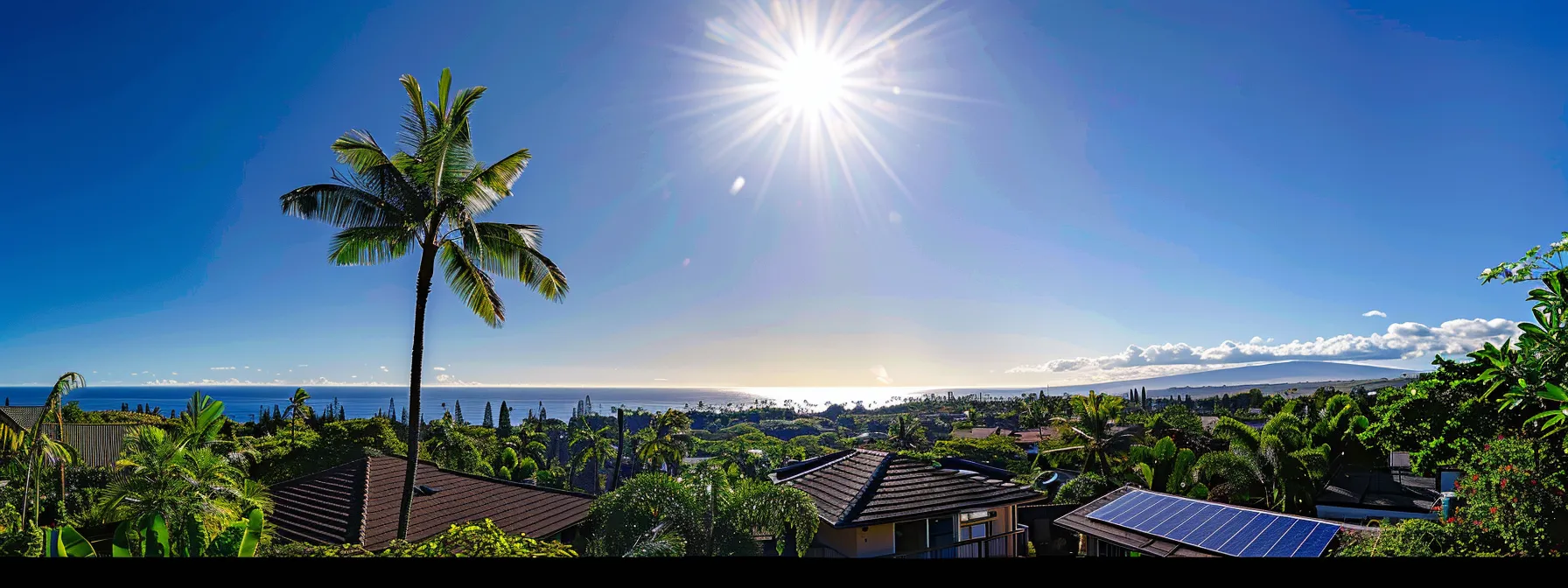
In my role as a Big Island home inspection expert, I’ve seen the remarkable potential of harnessing solar power to curb cooling costs in Hilo’s homes. I advocate for renewable energy solutions that are not only environmentally sound but also financially savvy. The following sections will explore recommended renewable options, such as solar power, and evaluate the tangible benefits these investments yield for sustainable cooling in our tropical climate.
Harnessing Solar Power to Offset Cooling Costs
During my years conducting home inspections in Hilo, I’ve seen the substantial impact solar power can have on reducing cooling costs. It is an investment that pays for itself over time, converting our abundant sunshine into a robust energy source to power efficient cooling systems. Indeed, residential solar installations boost property value and contribute to a home’s energy independence, a direct advantage in our sun-rich climate.
In my professional recommendations, I often underscore the fact that solar power isn’t simply about energy savings; it’s a strategic asset in Hilo’s battle against high electricity rates. By tapping into solar energy for home cooling needs, homeowners can enjoy consistent, cost-effective comfort while significantly lowering their carbon footprint. The following table illustrates the relationship between solar panel output and cooling requirements, based on my inspections:
| Month | Average Solar Energy Generated | Estimated Cooling Energy Usage |
|---|---|---|
| January | High | Moderate |
| June | Peak | High |
| December | High | Moderate |
Renewable Energy Options Recommended by Home Inspection Hawaii Experts
In my professional evaluations of Hawaiian homes, I’ve consistently recommended geothermal heat pumps as a renewable energy solution for Hilo’s climate. These systems utilize the stable underground temperatures to provide efficient cooling, posing as a less commonly known yet highly effective alternative to traditional air conditioning. For those of us living in Hilo, tapping into geothermal energy can be particularly advantageous, given the proximity to volcanic activity, which naturally heats the ground, creating a promising energy source for eco-friendly cooling.
Another renewable option I advocate for is installing small-scale wind turbines where feasible. While solar power shines as a leading renewable resource in Hawaii, wind power can complement it by harnessing our island‘s strong trade winds. This holistic approach not only ensures a more reliable energy supply for home cooling systems but also aligns with Hawaii‘s commitment to reducing its carbon footprint and achieving energy self-sufficiency. My inspections often reveal the untapped potential for blending these renewable resources to create an energy-smart home in Hilo’s tropical setting.
Evaluating the Benefits of Sustainable Cooling Investments
Through my expert lens as a home inspector, I’ve witnessed the direct benefits homeowners reap from investing in sustainable cooling solutions in Hilo. Not only do these renewable systems reduce reliance on conventional energy with high running costs, but they also enhance property values, making them a smart financial move for the future. They are an effective response to our tropical climate’s demands on energy consumption, offering an environmentally friendly option that aligns with Hawaii‘s wider sustainability goals.
The commitment to sustainable cooling methods is more than environmental stewardship; it’s a practical strategy for long-term financial savings. Take, for instance, solar panels; their upfront costs are offset by the long-term savings on utility bills. My clients in Hilo who have embraced these solutions often highlight the tangible difference in their energy expenditures:
| Installation | Estimated Initial Cost | Estimated Annual Savings |
|---|---|---|
| Solar Panels | Varies | 20-30% |
| Geothermal Heat Pump | High | 30-40% |
| Wind Turbine | Subject to site evaluation | 10-15% |
Frequently Asked Questions
How does Hilo’s climate affect home cooling needs?
Hilo’s humid climate calls for efficient cooling systems to mitigate the frequent, warm rainfall, ensuring comfort in homes and preventing moisture damage.
What are common cooling inefficiencies found in Big Island homes?
In Big Island homes, common cooling inefficiencies stem from poor insulation, outdated HVAC systems, and air leaks, which can lead to increased energy consumption and costs.
How can improved insulation help with Hilo’s heat?
In Hilo, improved insulation conserves energy, reduces heat transfer, and decreases cooling costs, making living spaces more comfortable and energy-efficient in Hawaii‘s tropical climate.
What natural methods can enhance home cooling in Hilo?
In Hilo, enhancing home cooling naturally can be achieved through strategic landscaping for shade, cross-ventilation practices, and utilizing reflective roofing materials to deflect heat.
Are there renewable energy options for cooling in tropical climates?
Yes, tropical climates can benefit from solar-powered air conditioning and geothermal cooling systems to harness renewable energy for efficient temperature regulation.
Conclusion
In Hilo’s warm and humid climate, energy-smart home cooling solutions are essential for comfort, health, and financial efficiency. As a seasoned home inspection expert, I advocate for the strategic use of insulation, natural ventilation, and renewable energy technologies to combat excessive heat and reduce reliance on costly air conditioning. My professional recommendations and insights enable homeowners to enhance their property‘s energy profile and achieve significant utility cost savings. Prioritizing these sustainable cooling methods not only aligns with Hawaii‘s environmental goals but also adds tangible value to your home.


No Comments